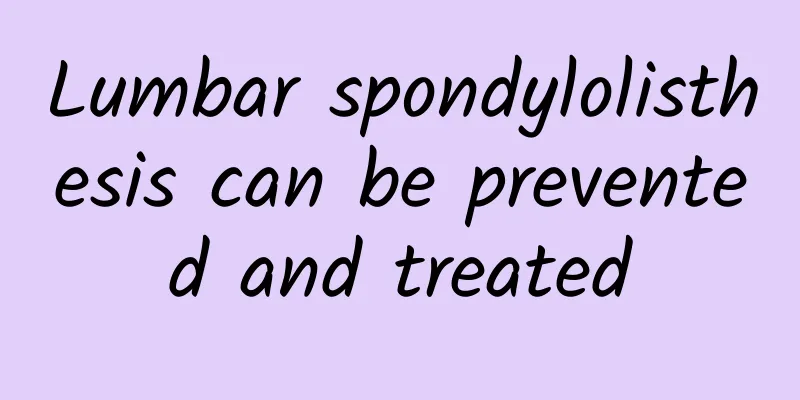Lumbar spondylolisthesis can be prevented and treated

|
As the name suggests, lumbar spondylolisthesis means that the upper lumbar vertebra has moved relative to the next lumbar vertebra, usually forward, but rarely backward. Divide the vertebral body of a vertebra into four equal parts from back to front. If the vertebra slides one quarter relative to the other, it is a 1-degree slip, and if it slides completely, it is a 4-degree slip. There are five segments of the lumbar spine, and each segment may slip. The fifth lumbar vertebra at the bottom may slip relative to the sacrum. The causes of lumbar spondylolisthesis include both congenital and acquired factors. Congenital causes are developmental problems. For example, spina bifida or spondylolysis are caused by incomplete development of the bones of the spine, which are naturally not strong enough. As age increases and weight increases, the ligament structure becomes loose, and the spinal joints shift due to gravity, causing slippage. The most common ones are caused by acquired factors, such as bending over and carrying heavy loads for a long time, or sudden violent injuries, or strain leading to the tearing of the ligaments and joint capsules that constrain the vertebrae, rupture of the intervertebral discs that connect the vertebrae, and even fractures of the bones in the isthmus of the vertebrae, which can all lead to lumbar spondylolisthesis. In the early stage of lumbar spondylolisthesis, symptoms manifest as soreness and pain in the lumbosacral region, especially when bending over or bearing weight. Straightening up and tapping the lumbosacral region with fists can relieve the symptoms. As the disease progresses, it will compress the nerves that control the lower limbs, causing pain in the knees and hips, which can be easily misdiagnosed as hip or knee joint diseases. Some symptoms manifest as pain along a line on the back or outside of the thigh or calf, and may also be accompanied by numbness in the feet. Severe cases make it difficult to walk, and both hands cannot hold weight. Most mild cases of lumbar spondylolisthesis can be cured with traction, massage and systematic conservative treatment. Only some severe cases require surgical treatment. Patients with lumbar spondylolisthesis should pay attention to self-protection, sit properly, and avoid sitting for long periods of time and bending over for long periods of time. When the waist is uncomfortable, stop the work at hand in time, rest and seek appropriate treatment. You can also insist on doing waist and back muscle exercises 1-2 times a day, 10 minutes each time, which will have obvious effects. Exercises include "Little Swallow Flying", five-point support and "Wind-swaying Lotus Leaf". (Li Wuqiang, Director and Chief TCM Physician of Sanmenxia Wuqiang Traditional Chinese Medicine Hospital) |
<<: Children with poor attention span, rehabilitation therapy can help you
>>: Be careful! A "cold" may be fulminant myocarditis
Recommend
Should I heat the fruit after induced labor?
You also need to pay special attention to your bo...
What does a woman's round nose mean?
There is a saying in physiognomy: A round nose me...
New hope for allergic diseases: Shi Yigong's team's new discovery published in Nature
A-choo! Whether it’s the sound of sneezes coming ...
What causes endometriosis?
Endometriosis is a common and frequent gynecologi...
What are the combinations of chrysanthemum tea? What kind of chrysanthemum tea is good for women?
We all love to drink chrysanthemum tea, but drink...
Pictures of vaginal polyps
The health of women's vaginal opening is extr...
What are the reasons why girls have high body temperature?
Body temperature can be used to show the health s...
What Chinese medicine is better for women to nourish the kidneys?
In today's society, people pay more and more ...
How can I shrink my vagina quickly?
Because after marriage, women may have more frequ...
Is it accurate to identify the gender of the fetus by heart rate?
Being able to give birth to a healthy baby is ver...
How to remedy postpartum visceral prolapse
The body needs some time to recover after giving ...
Will hcg levels increase during menstruation?
High hcg mainly represents many types. First of a...
What should women do if they have less hair?
Women tend to care more about how they appear to ...
Can breastfeeding women get pregnant?
Many breastfeeding women do not know that they ca...









